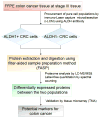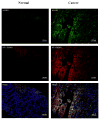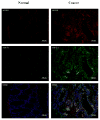Protein Markers Associated with an ALDH Sub-Population in Colorectal Cancer
- PMID: 28503055
- PMCID: PMC5423664
- DOI: 10.4172/jpb.1000412
Protein Markers Associated with an ALDH Sub-Population in Colorectal Cancer
Abstract
ALDH has been shown to be a marker that denotes a sub-population of cancer stem cells in colorectal and other cancers. This sub-population of cells shows an increased risk for tumor initiation, metastasis, and resistance to chemotherapy and radiation resulting in recurrence and death. It is thus essential to identify the important signaling pathways related to ALDH1+ CSCs in colon cancer. The essential issue becomes to isolate pure sub-populations of cells from heterogeneous tissues for further analysis. To achieve this goal, tissues from colorectal cancer Stage III patients were immuno-stained with ALDH1 antibody. Target ALDH1+ and ALDH1- cells from the same tissue were micro-dissected using Laser Capture Microdissection (LCM). Captured cells were lysed and analyzed using LC-MS/MS where around 20,000 cells were available for analysis. This analysis resulted in 134 proteins which were differentially expressed between ALDH1+ and ALDH1- cells in three patient sample pairs. Based on these differentially expressed proteins an IPA pathway analysis was performed that showed two key pathways in cell to cell signaling and organismal injury and abnormalities. The IPA analysis revealed β-catenin, NFκB (p65) and TGFβ1 as important cancer-related proteins in these pathways. A TMA validation using immunofluorescence staining of tissue micro-arrays including 170 cases was used to verify that these key proteins were highly overexpressed in ALDH1+ cells in colon cancer tissues compared to ALDH1- cells.
Keywords: ALDH; Colon cancer; FFPE tissue section; LC-MS/MS; LCM.
Figures







References
-
- Weyl H, Yackzan S, Ross K, Henson A, Moe K, et al. Understanding colorectal screening behaviors and factors associated with screening in a community hospital setting. Clin J Oncol Nurs. 2015;19:89–93. - PubMed
-
- Sabbagh C, Chatelain D, Trouillet N, Mauvais F, Bendjaballah S, et al. Does use of a metallic colon stent as a bridge to surgery modify the pathology data in patients with colonic obstruction? A case-matched study. Surg Endosc. 2013;27:3622–3631. - PubMed
-
- Lurje G, Zhang W, Lenz HJ. Molecular prognostic markers in locally advanced colon cancer. Clin Colorectal Cancer. 2007;6:683–690. - PubMed
Grants and funding
LinkOut - more resources
Full Text Sources
Other Literature Sources
Miscellaneous
